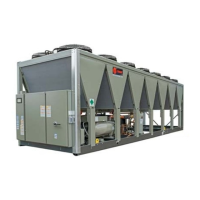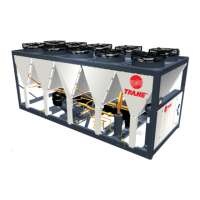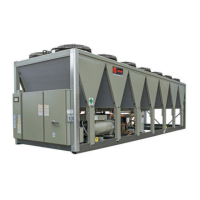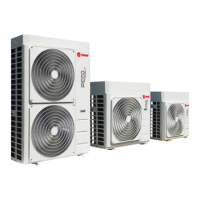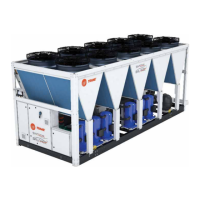CTV-PRB004-EN 73
Glossary
A
Acceleration time
The time it takes a motor to reach full design speed from
the moment power is applied. Typical CenTraVac motor
acceleration times associated with various starter types
are listed in Table 5, p. 17 (low voltage) and Table 7, p . 31
(medium voltage).
Advanced motor protection system
Standard motor protection provided by the CenTraVac
microprocessor-based control panel. By monitoring
current and voltage in each of the three motor power
phases, the panel provides protection throughout the
motor starting and running modes from the adverse
effects of phase imbalance, phase failure, phase reversal,
overvoltage, undervoltage, and electrical distribution fault
(momentary power loss). Sensing any of these faults, the
panel trips-out the motor instantaneously and provides a
diagnostic display. The chiller controller also protects
“adaptively” for overcurrent. By reducing the load, it may
be able to avoid a shutting down the chiller once it reaches
the current limit.
Automatic restart is provided after restoration of power
when
the
stoppage is caused by distribution fault or
extended power loss.
Air break
Contacts exposed to open air that rely on an air gap to
keep an electrical circuit open. Air break contactors are an
obsolete technology that has been replaced by vacuum
break contactors. See “Vacuum break,” p. 81.
Aluminum conductors
Trane requires that power wiring to the motor use copper
conductors. Aluminum conductors are not suitable for the
following reasons:
•UL requirements
•Galvanic corrosion
•Higher probability of connection failure
•Terminal block design
Galvanic corrosion occurs
when
air and moisture are
present at an aluminum-copper connection. The resulting
electrolysis process causes the loss of aluminum at the
interface of the dissimilar metals.
Another reason to use copper conductors is the
decreased
probabilit
y of connection failure. Aluminum
connections require greater care at initial installation as
well as periodic maintenance and inspection because of
oxidation, torque requirements, cold flow, and thermal
expansion coefficients.
Greater care in connecting aluminum wire is required
since
an aluminum
oxide film must be removed or
penetrated before a reliable aluminum joint can be made.
This oxide film insulates the aluminum and increases joint
resistance.
Torque requirements are
critical
when aluminum
connections are made. It is difficult to ensure that these
requirements will be met at the time of installation.
Cold flow or
“creep”
results because aluminum has a
lower modulus of elasticity than copper and tends to
creep away from a stressed area when under pressure.
The resulting loosened connection can increase joint
resistance and lead to failure of the connection. Periodic
maintenance and inspection is required to assure good
connections.
Aluminum and copper have different thermal
e
xpansion
coefficients. Aluminum expands 36 percent more than
copper under
thermal cycling. When the terminals and
connections are subjected to a large temperature change,
a gap may open between the aluminum cable and the
copper lug. This, combined with cold flow, can result in a
very high resistance joint and lead to failure of the
connection.
The final reason to use copper conductors is terminal
bloc
k
design. Because aluminum electrical conductivity is
about 60 percent that of copper, larger aluminum cables
are required
to conduct the same amount of current.
These larger cable sizes may not fit terminals designed for
copper. It is also possible that the block itself may not be
suitable for use with aluminum wire as determined by the
block manufacturer.
Amps, motor full-load amps (FLA)
FLA is the amperage the motor would draw if it was
loaded to its full rated capacity, i.e. motor size kW. The
FLA is not available from the selection program; however,
it can be obtained from CenTraVac Field Sales Support.
Amps, motor locked-rotor amps (LRA)
Once a motor has been selected, there is a specific locked
rotor amperage value associated with the specific motor.
This is the current draw that would occur if a motor was
running, and then the rotor shaft was instantaneously held
stationary. LRA is typically 6–8 times that of the motor full-
load
amps
(FLA). LRA is also used commonly in
discussing different starter types and the amperages
associated with the start.
CTV-PRB004.book Page 73 Sunday, December 18, 2011 6:39 PM

